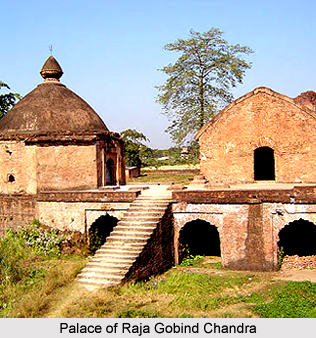 History of Cachar District talks about a number of chronological changes behind the formation of this district of Assam. It recollects that the last of the Kachari Kings, Raja Gobind Chandra was assassinated by a group of rebellious persons with the help of some of his personal attendants on April 24th, 1830 at Haritikar. In the absence of natural heirs, his territory lapsed to the British under the terms of an agreement executed in 1826. T. Fisher, as army officer was sent to take charge of the territory with the power of a collector and magistrate and he took over the entire charge on June 30th, 1830 with headquarters at Cherrapunji.
History of Cachar District talks about a number of chronological changes behind the formation of this district of Assam. It recollects that the last of the Kachari Kings, Raja Gobind Chandra was assassinated by a group of rebellious persons with the help of some of his personal attendants on April 24th, 1830 at Haritikar. In the absence of natural heirs, his territory lapsed to the British under the terms of an agreement executed in 1826. T. Fisher, as army officer was sent to take charge of the territory with the power of a collector and magistrate and he took over the entire charge on June 30th, 1830 with headquarters at Cherrapunji.
In the year 1833, the headquarters were shifted to Dudpatil and then to Silchar. The plain portion of the Cachar was formally seized by the British dominion on August 14th, 1832 by a decree of the Governor General in council. Further, T. Fisher was appointed as the first post of the Superintendent of this district. After his death, Messers I.G. Burns, E.R. Lyons, E.S. Person, P.G. Vener and others, succeeded his charges respectively.
As per the historical recounts associated with Cachar District, in the year 1854 North Cachar was annexed to the British Dominion after the death of Senapati Tularam. Again, in 1874, Cachar was included under the authority of the Chief Commissioner of Assam according to the proclamation of 6th February 1874 and the post of Superintendent was re-designated as Deputy Commissioner. R. Stuart was the first Deputy Commissioner of the District. Hailakandi Sub-Division was formed on June 1st, 1869. After the partition of India in 1947, four police stations of former Karimganj sub-division of Sylhet District were transferred to Cachar District.
The Cachar District is located in the Southernmost part of Assam is one of the oldest district of Assam. The British created it in the year 1830 after the annexation of Kachari Kingdom. In 1854, North Cachar was annexed and tagged to the district. In 1951, the erstwhile North Cachar sub-division was made a separate district and taken out of Cachar District. Further in the year 1983, previous Karimganj sub-division and in 1989, Hailakandi District sub-division was made a separate District.
Moreover, the history of Cachar District also suggests that there are two possibilities regarding the origin of the name of this district. These are - firstly, the Kacharis gave this name Cachar when they ruled this land and secondly, the word Kachar in Sylheti means a stretch of land at the foot of a mountain. Thus, it is assumed that the Bengali people of Sylhet might have given the name Cachar as the land is surrounded by several mountains.
The available historical accounts in connection with the Cachar District also specify the interesting circumstance under which the Kacharis came and ruled this land. It states that in December of the year 1706, the most powerful Ahom king Rudra Singha invaded the Kachari King Tamradhaja, whose capital was at Maibong on the bank of the Mahur River. Being defeated by the Ahom King, Tamradhaja fled southwards to Khaspur. From this time onwards the Kachari prince seemed to have settled in the plains of Cachar, their court being located at Khaspur. Further, the first connection of British with this district dates back to 1762. The next historical event of importance associated with Cachar District recounts the formal conversion of King Krishna Chandra to Hinduism in 1770. Marjit Singha of Manipur with the help of the Burmese drove a few years later last prince Gobinda Chandra from his throne. Afterwards the Burmese drove Marjit Singha from this place to Surma Valley. But the British Government which was in possession of Sylhet expelled the Burmese and handed back the district to Gobinda Chandra. In return, he was required to pay an annual tribute of Rs.10, 000. The king then shifted his abode to Haritikar, but in the year 1830, he was assassinated. In the absence of a natural heir, this territory lapsed to the British Government under the term of a treaty executed in the year 1826. Finally, the Cachar District was formally annexed by the proclamation of August 14th, 1832.



















